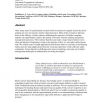Free Online Productivity Tools
i2Speak
i2Symbol
i2OCR
iTex2Img
iWeb2Print
iWeb2Shot
i2Type
iPdf2Split
iPdf2Merge
i2Bopomofo
i2Arabic
i2Style
i2Image
i2PDF
iLatex2Rtf
Sci2ools
SAFECOMP
2001
Springer
2001
Springer
Designing Safety into Medical Decisions and Clinical Processes
After many years of experimental research software systems to support clinical decisionmaking are now moving into routine clinical practice. Most of the research to date has been on the efficacy of such systems, addressing the question of whether computer systems can significantly improve the quality of doctors' decision-making and patient management processes. The evidence that they can make a major improvement is now clear and interest is beginning to turn to the question of how we can make such systems safe. We outline some example applications and discuss what we can learn in developing safety cases for such applications from the work and experience of the software safety community. Some distinctive challenges also arise in medicine, and some novel safety management techniques to address them are being developed.
Patient Management Processes | Research Software Systems | Routine Clinical Practice | SAFECOMP 2001 | Security Privacy |
| Added | 30 Jul 2010 |
| Updated | 30 Jul 2010 |
| Type | Conference |
| Year | 2001 |
| Where | SAFECOMP |
| Authors | John Fox |
Comments (0)

